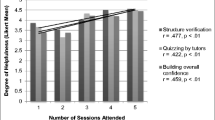Abstract
Introduction
In response to student demand for additional anatomy lab instructional time outside of typical teaching hours, a peer-based anatomy tutoring program was implemented at the David Geffen School of Medicine at UCLA. Peer tutoring is a well-studied form of supplemental instruction, and is known to benefit students and tutors alike. This study aims to address the effect of tutoring on the tutors themselves, specifically in the context of the gross anatomy laboratory.
Methods
A one-time 12-question survey was distributed to all students who acted as tutors over a three-year period (n = 57), asking them to reflect on their experiences as tutors. Specifically, we aimed to address their thoughts on their career plans and academic achievement as they relate to their experience as tutors, as well as their opinions on effective tutoring techniques.
Results
Based on a 100% response rate, 85.7% of tutors reported being “very interested” in incorporating a teaching component to their career, and 73.7% of respondents reported that their experience tutoring influenced this plan. In contrast to an expectation that tutors would skew their residency choices toward anatomy-focused specialties, the distribution of tutors’ anticipated specialty choices actually reflected the overall distribution of the class. The tutors believed their experience tutoring improved their academic and clinical performance. The overwhelming majority reported believing that their experience as a tutor improved their USMLE Step 1 score (90.2%, n = 46). Sixty-one percent (n = 31) reported feeling that the experience as a tutor helped with their clerkship evaluations. Finally, the most effective tutoring techniques were quizzing the students directly and using the tutors’ own notes and study materials from the prior year.
Discussion
This study supports the finding that tutoring provides a significant beneficial effect on the tutors based on their own perceptions, and further studies obtaining quantitative data on academic achievement and clinical performance of the tutors will be beneficial.


Similar content being viewed by others
References
Dinsmore CE, Daugherty S, Zeitz HJ. Teaching and learning gross anatomy: dissection, prosection, “both of the above?”. Clin Anat. 1999;12:110–4.
McMenamin PG et al. The production of anatomical teaching resources using three-dimensional (3D) printing technology. Anat Sci Educ. 2014;7(6):479–86.
Sugand K, Abrahams P, Khurana A. The anatomy of anatomy: a review for its modernization. Anat Sci Educ. 2010;3(2):83–93.
Davis CR et al. Human anatomy: let the students tell us how to teach. Anat Sci Educ. 2014;7(4):262–72.
Winkelmann A. Anatomical dissection as a teaching method in medical school: a review of the evidence. Med Educ. 2007;41(1):15–22.
Drake RL, McBride JM, Pawlina W. An update on the status of anatomical sciences education in United States medical schools. Anat Sci Educ. 2014;7:321–5.
Krych AJ et al. Reciprocal peer teaching: students teaching students in the gross anatomy laboratory. Clin Anat. 2005;18(4):296–301.
Moore-West M, Hennessy SA, Meilman PW, O'Donnell JF. The presence of student-based peer advising, peer tutoring, and performance evaluation programs among U.S. medical schools. Acad Med. 1990;65(10):660–1.
Escovedo C et al. Utility and efficacy of a peer-based anatomy tutoring program for first-year medical students. Medical Science Educator. 2016;26(1):105–9.
Escovitz ES. Using senior students as clinical skills teaching assistants. Acad Med. 1990;65:733–4.
Field M, Burke JM, McAllister D, Lloyd DM. Peer-assisted learning: a novel approach to clinical skills learning for medical students. Med Educ. 2007;41:411–8.
Sobral DT. Cross-year peer tutoring experience in a medical school: conditions and outcomes for student tutors. Med Educ. 2002;36(11):1064–70.
Buckley S, Zamora J. Effects of participation in a cross year peer tutoring programme in clinical examination skills on volunteer tutors’ skills and attitudes towards teachers and teaching. BMC Med Educ. 2007;7:20.
Author information
Authors and Affiliations
Corresponding author
Rights and permissions
About this article
Cite this article
Harrison, D., Lentz, J., Schmalz, N. et al. Peer-Based Anatomy Tutoring for First-Year Medical Students: an Analysis of Peer-Tutoring from the Tutors’ Perspective. Med.Sci.Educ. 27, 57–61 (2017). https://doi.org/10.1007/s40670-016-0361-5
Published:
Issue Date:
DOI: https://doi.org/10.1007/s40670-016-0361-5




